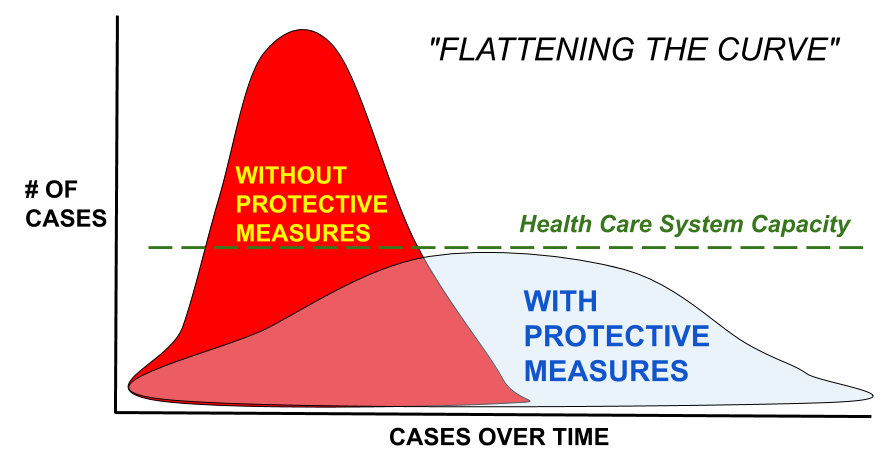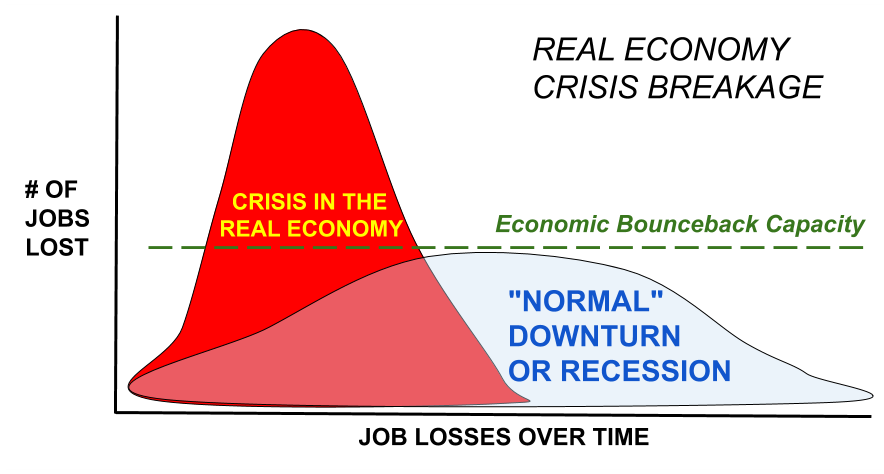How Systemic Breakage and “Flattening the Curve” Helps Explain the Real Economy Crisis
We’ve been trying to find ways to explain, in simple terms, why the market has not bottomed and the economy won’t bounce back quickly.
We feel the need to press this point because so many analysts are going the other way — and we feel strongly they are making a mistake.
For investors, it could be a very costly error to bet on “the bottom” here with committed capital in a big way, or to make decisions that assume a “normal” economy within a few months’ time. Hence our interest in pushing back.
To make the point, we argued that the odds of a V-shaped recovery are zero. We also explained why Wall Street analysts should throw away their models.
And on April 2 we saw another stunning jobless claims number — 6.6 million.
The prior jobless claims number of 3.3 million blew away all records. The next one did it twice over. And so, as of this writing, more than 10 million Americans are newly jobless and seeking unemployment benefits.
The tally of the last two weeks was 9.9 million, but the actual number is almost certainly above 10 million because of “systemic breakage,” meaning, the systems designed to handle the routine inflow of unemployment claims are literally breaking down.
Due to systemic breakage, not all Americans who lost their jobs were able to file successfully. Various reports indicate state-run websites and phone lines were swamped, leading to crashed web pages and hold times measured in hours.
On top of that, a large number of students and cash-based or “gig economy” workers — groups that can’t or won’t file — have surely been added to the jobless ranks.
This is breakage of another kind, in which a group of Americans in need finds out the system can’t help them in the first place.
As it turns out, “systemic breakage” is also a way to explain why a real-economy crisis is so dangerous — and so different from anything we’ve seen before.
On March 12 we explained why “flattening the curve” means sacrificing the economy. You have almost certainly heard that phrase by now. The whole world is talking about it with respect to beating the pandemic.
In that piece, we included a graphic which is shown again below.

The point of flattening the curve, as you likely know, is to protect the hospital system. If we get too many cases at once, there is “systemic breakage” as the nation’s hospitals are overrun.
This was a strange concept at first, but most people understand it now. The difference is down to tragic images and news headlines coming out of New York, Italy, Spain, and other places. We are getting an awful real-time tutorial in what systemic breakage really means.
The reason we bring this up is to highlight an important parallel.
- It’s not just the hospital system that can experience systemic breakage — the phenomenon where a spike in caseloads overwhelms capacity, causing normal processes to break down.
- The same thing can happen to the real economy — meaning the jobs and businesses that drive Main Street rather than Wall Street. The real economy can experience systemic breakage, too.
Take a look at the modified graph below. We started with the original “flatten the curve” graph — as applied to COVID-19 cases and the hospital system — and changed the labels.
Now it applies to what’s happening in the real economy.

The modified graph shows job losses instead of COVID-19 cases. The blue area, indicating a “normal” downturn or recession, shows what happens when job losses are dispersed over time.
The red area shows what happens when job losses spike. You get “systemic breakage” in the economic system, the same way a nightmare caseload overwhelms the hospital system.
Think about why a quasi-free-market economy is resilient in the first place.
In a functional economy, jobs are being created and destroyed on a constant basis. At the same time, small businesses are responsible for roughly two-thirds of all job creation in the United States.
In normal times, the economy is resilient because job losses and business failures are spread out. In a real-economy crisis — like the one we’re experiencing now — the losses and failures spike, creating systemic breakage as economic bounceback capacity is overwhelmed. For example:
- If, say, 15 million workers in the restaurant, retail, and travel industries lose their jobs over a two-year period, the economic system can handle that. The laid-off workers find new jobs, perhaps in new industries. Unemployment benefits help bridge the gap. The economy self-adjusts and rolls along with bounceback capacity intact.
- But when 15 million workers lose their jobs in the span of two months rather than two years, that is an entirely different outcome. It is the red peak in the graph above — representing a “crisis in the real economy” — versus a lagged distribution that the system can absorb.
The same logic applies to small business entities.
It is a normal thing for small businesses to fail — in fact it happens all the time, and this is healthy.
But there is a huge difference between, say, the failure of nine million small businesses over the course of two years, and the failure of nine million businesses in the space of eight weeks.
To understand how economic systems can break under sudden strain in the same way hospitals can, think about a bank portfolio of commercial mortgage loans.
In normal times, a bank can expect a certain percentage of mortgages to default. This rate of default is factored into the bank’s lending decisions.
Usually a bank will calibrate its lending decisions to keep the rate of default in the low single digits. So, hypothetically speaking, if 3% of the loans in a commercial mortgage portfolio go into default, the bank has no problem. They likely factored a 3% default rate into their calculations in the first place.
Now let’s say that number triples, so that 9% of the loans are in default.
At 9% the bank is in trouble. At such a high rate of default, they are probably losing money on the portfolio instead of making it. At 9% the bank is eating more in losses than it is bringing in through payments.
But of course, the statistical wizards in the bank’s risk management department would never anticipate a 9% default rate. That level of default, for the given quality of borrowers in the portfolio, spread across thousands of loans, would be unprecedented. There is no “9% scenario” in their models.
And then a real economy crisis comes along, and the default rate spikes to 20% — the equivalent of a biblical flood — and the bank is stunned by a gigantic capital loss it never expected or anticipated.
Take that basic idea, multiply it by 10,000 to reflect all the myriad ways a real economy crisis breaks the system — not just for banks but all kinds of actors and entities and linkages — and you’ll start to get an idea of why the economic situation is dire right now, and far from easily fixed.
“Systemic breakage” is real and pervasive when a system’s capacity is exceeded. The concept is a basic principle of nonlinear dynamics.
For another off-the-cuff example, think about the total amount of calories a person consumes in two years, and then imagine being forced to eat that much in two months. Or imagine being forced to do two years’ worth of manual labor in two months.
In the first case your digestive system would collapse. In the second you drop dead from exhaustion.
It’s not just the amount of throughput that goes through the system, in other words, it’s the speed and volume at which the system is forced to handle it.
Plumbers, engineers, and mechanics are intimately familiar with concepts like these because they build and maintain physical systems in the real world, where nonlinear dynamics apply on a regular basis. Too much water pressure bursts the pipe; too much tension snaps the rod; too much friction burns out the motor, and so on.
All this stuff applies in the real economy, too. And with the kind of crisis the real economy is facing now, with many more weeks of shutdown yet to go, the level of systemic breakage is unprecedented — and the horrifying spike in jobless claims is only a fraction of all that’s gone wrong.
We see this quite clearly, which is why the idea of a near-term bounceback — and a relatively fast market bottom — seems nuts.
When you get the level of breakage we’re seeing now, it just doesn’t work that way.